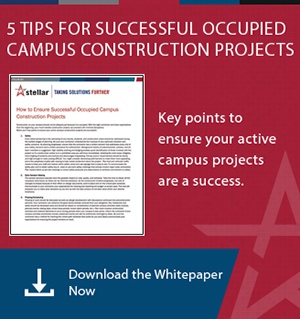Food and beverage is a fast-paced industry where speed-to-market is often a major factor in how decisions are made. Sometimes the priority is increasing output and/or beginning production as soon as possible. In these cases, some plant owners decide to take a phased-occupancy approach to a greenfield or renovation project.
Phased occupancy allows project owners to begin using as much of their new building as possible, as early as possible.
Here’s how it works:
- The contractor completes an area of the project that can be separated from existing and continuing construction
- The owner gets a temporary certificate of occupancy (TCO)
- Operations can begin in those finished areas while the rest of the facility is constructed
Sounds efficient, right? It can be, but this approach can also create delays and headaches if not executed correctly. For the past year I’ve been working on a phased-occupancy project to renovate a warehouse into a food production and packaging facility, and I’ve observed lessons that any owner considering a similar approach can benefit from.
1. Finalize the design before starting construction
It’s critical that you nail down the design of your facility ahead of time, because it’s harder to make changes once part of the facility is occupied and operational. You can’t go back and kick out everyone who is now working in the completed TCO area of the facility so that you can redo something.
Finalizing your design includes determining the placement of your equipment. Equipment location affects a number of other factors in your facility, including:
- Air ducts and ventilation
- Water piping and drainage
- Electrical wiring to power the machines
- Ethernet connections and network data
Plus, any changes you make after the fact could delay the delivery of equipment and other items. For example, you may have initially ordered a piece of equipment that is scheduled to take 4 weeks to deliver. If your change-up to the design requires a different piece of equipment that takes 8 weeks for delivery, you’ve just delayed your entire project.
The sooner you can finalize all of your design and equipment details, the better.
2. Construct your building around the process (not vice-versa)
Trust your design and construction teams when it comes to timeline and how your facility will be built. (They’ve done this a few times before!)
I always encourage owners to build their facility around the construction process, not to force the process to fit the building. In other words, come to the table with ideas for your facility, but trust your firm’s discretion when it comes to areas where corners can’t be cut, such as:
- Employee safety
- Production efficiency
- Equipment lead times
This applies to target completion dates as well. Have an ideal timeframe in mind, but be flexible and understand that your contractor can help determine what’s feasible when factoring in parts of the construction process that have rigid constraints.
3. Tighten your Good Manufacturing Practices to ensure food safety
Food safety and avoiding cross-contamination is paramount in any food and beverage facility, but extra steps need to be taken when product handling and construction are happening on the same site. During a phased-occupancy project, your Good Manufacturing Practices (GMPs) must be more strict to control the flow from the construction side to the TCO side.
Here are some basic steps you can take:
- Invest in more protective gear — Stock up on more gear (gloves, hair and beard nets, footwear, etc.) than you might typically need during normal operations. You may go through more than usual and it’s crucial to have enough while construction is taking place under the same roof.
- Limit the number of entrances/exits to construction zones and TCO areas — This minimizes the risk of cross-contamination and reduces the chances of a contractor accidentally entering a food-safe area. Having less access points also cuts down on the amount of personnel you need to monitor them.
- Strictly monitor GMP plan — Craft a thorough and clear GMP plan and ensure it’s followed strictly. Place checks and balances in place to make sure best practices are followed from management down to the plant floor.
4. Plan for reduced available parking
It may seem like a minor detail, but running out of parking space can create unnecessary confusion and delays if it sneaks up on you.
For example, say you have 300 parking spots on-site and about 250 contractors working on a daily basis at the beginning of the project. Your parking lot is mostly full. Once half the building is completed, you may hire 200 people to start working in that completed TCO side of the facility, but there are still 150 contractors working on the remainder of the building. Suddenly, you have 350 people showing up for work every day but only 300 parking spaces in your lot.
Contractors can always carpool and figure out other space-saving solutions, but it’s important to plan for this possibility in advance so that it doesn’t catch you off guard.
5. Prepare for scheduled power outages
Once your staff is partially occupying your facility, there will still be contractors doing electrical work in other areas of the building. When the equipment is ready for final tie-ins, crews will need to shut down all power in the facility to safely connect and test it.
Once again, preparedness is key. The dates of these planned power outages typically aren’t determined until within a week of them occurring, so it’s important to time your facility’s production so that you can afford the 6 to 8 hours of downtime.
Also, any last-minute changes to those scheduled power outage times will only push back your project completion date — so plan in advance and plan accordingly!
Wondering if a phased-occupancy approach is right for your next project? Have questions about your specific needs? Leave a comment below!




